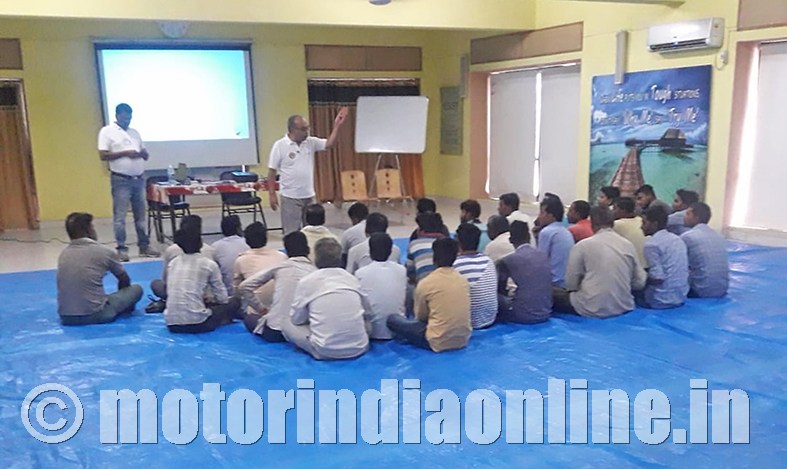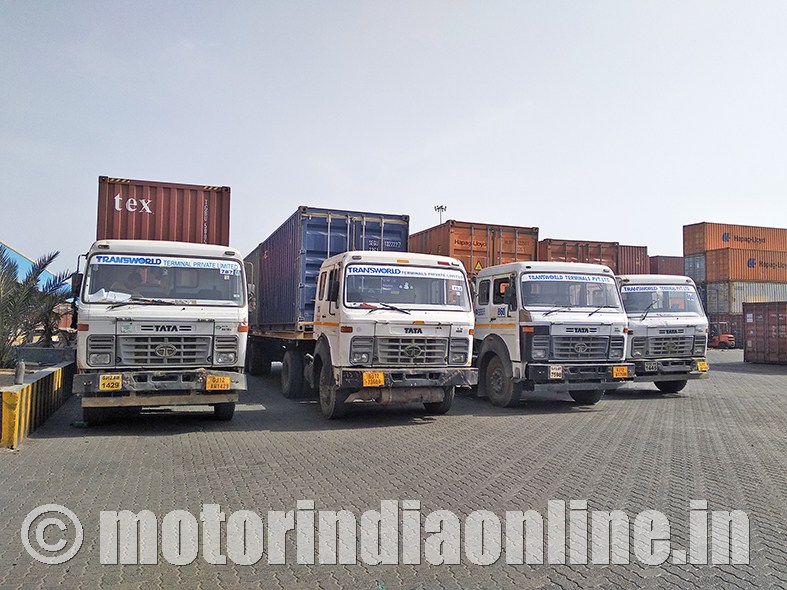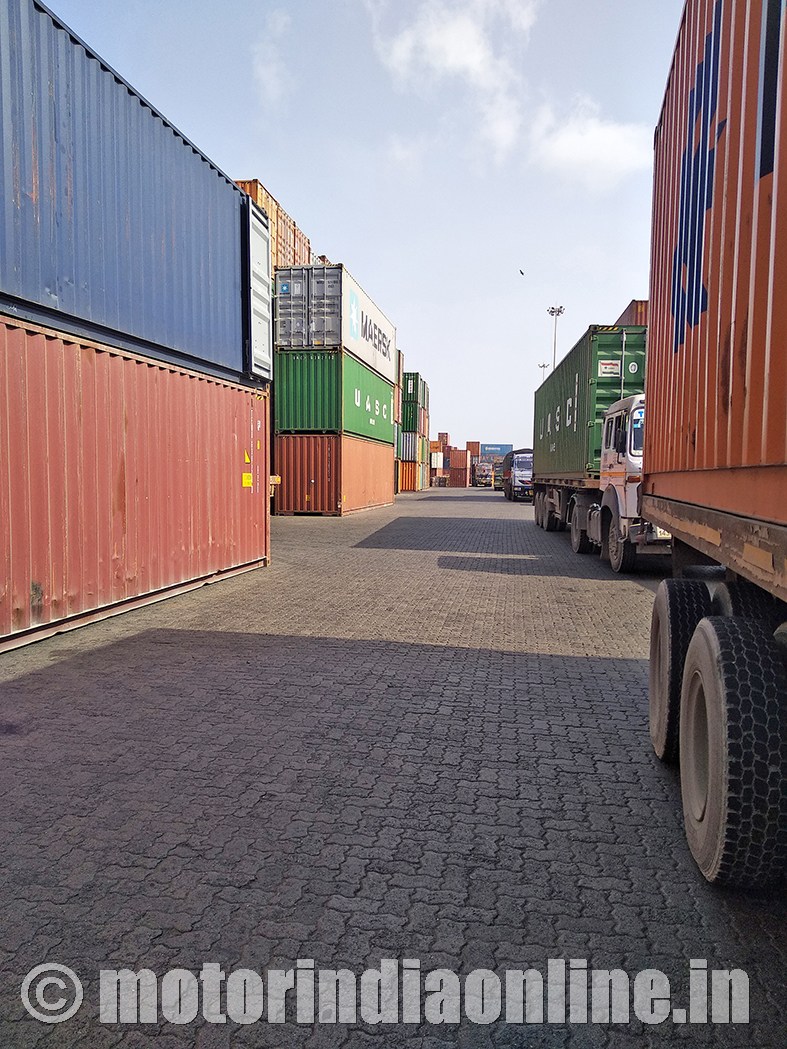Mundra, the “Container City”, has a lot of surprises to offer. The vast tracts of land once you enter this Adani-built port town is crowded with flatbed tractor trailers and high stacks of containers. In the Special Economic Zone where the terminal is situated, one can see miles and miles of 20 & 40 ft TEUs container-laden TTs.
The Mundra port in Gujarat is the biggest commercial port in the country in terms of the volume handled. A mind-boggling 100 million tonnes of cargo a year was achieved some two years back.
A look at the sea. Wow! What a sight. As far one could see into the sea it is dotted with ships. Hundreds of containers loaded on to these ships. Each container is loaded with tons of cargo which is essential for our daily life. Our clothing, our food and our medicines, to name a few.
And at the port yard, hundreds and thousands of containers stacked up neatly by the giant cranes. Export cargo, import cargo, empty containers, and so on and so forth. These trailer beds look like pigmies in front of the huge containers. But not to underestimate these flatbed tractor trailers which carry the larger than life containers from the Container Freight Service area to the port and back.
With the invent of container-based sea freight started the voluminous movement by the sea. Mundra has 65 tonne-capacity rail-mounted quay cranes capable of handling 18,000 TEU vessels. The yard equipment includes 12 rubber-tyred gantry cranes, each with 41 tonne-lift, which will accommodate seven rows of containers and one operational lane. The port boasts of handling one of the largest and longest container vessels in the world – MV MSC Valeria – having a capacity of 14,000 TEUs. Automation is the order of the day.
If anything has not changed in the days of automation, it is the role of the driver without whom the entire operation comes to a standstill. An army of short-haul truck drivers are tasked with hauling that cargo from the port complex to CFS areas. But despite their critical role at the ports, drivers are among the lowest paid workers.
We came here, all the way, to understand the plight of these drivers. To make it a win-win situation for both the company and the drivers. Productivity is taking a beat. We have to talk to these driver brethren. Pierce their shell and peep into their woes.
And when it comes to this driving community, nothing is different from any other part of the country. Slipper clad, banians of different hues and trousers. By and large, in the age group of 20-30. A few in their forties.
Majority of them are from far-flung States leading a bachelor life, away from their family and friends. Full orientation in the number of trips. More trips meant more money. The same as in the mines area. No uniforms, no shoes and no helmets.
We organised several meets. Some 30-odd drivers or fewer per day assembled. Talking among themselves in a hush-hush tone, we introduced ourselves. During the discussion, one among them grumbled: “What’s the use, Sir? We have seen people like you telling us to do this and do that. Drive this way or that way. Advising us to follow the rule of the road. Come with us and see what good it is to adhere to the rules. Even if we try following strictly and the other road users don’t, it will result in disaster. The policeman would invariably be behind our back in abusing us for none of our mistakes.”
Vastness of the port operation makes it doubly relevant to adhere strictly to the safety rules. Not just a mere formality but a sincere and pointed approach to comply with the safety requirement. An essential part of the whole exercise would be to train the drivers, operators and the supervisors about the nuances of safety. It should not be a onetime episode. Anything that has to merge as a second nature should have to be repetitive. Jaan hai to jahan hai. Nothing is more important than a human life. The daily work life of a port trucker is a tale of woes.
They don’t receive health care and their employers don’t contribute to any retirement fund. Most of them are paid a fixed amount and an incentive based on the number of trips. None of the drivers across the CFS units are directly on the pay rolls of the company.
Regardless of which company they work for, when they drive their trailers onto the container terminals in the port to pick up/drop a load, they usually have to wait. He could be sitting there, in his truck, for a long time, with no services, no bathroom. Drivers are not allowed to get out of their trailers once they enter the port complex.
The long wait en route, which is hardly 8 km, is in part due to unloading, sorting and the matching process at the docks whenever a vessel is docked. The bigger the vessel, the longer the wait.
Another day-to-day problem is to trace and carry the liner-specific containers from the empty park of third party CFS. It may be within the port area or even outside the terminal. That process also involves a lot of waiting, and often some hunting. Drivers have to find one that will match. These containers neither bear the RFID nor are stacked in a systematic manner. Thus, loss of time is loss of trips resulting in less take home.
Well, for an effective communication it is essential to give a sympathetic ear and express our empathy with their cause of discomfort. However right you might be, it is still pertinent to listen, be it a murmur or an explosion. Be it a useless braying or a banter, go along with them at least half way to bring them back to your reasoning. Get into their shoes if you want any fruitful outcome. Compared to the lives of the mine drivers it may appear to be better.
Personal safety of these drivers, irrespective of the CFS they are working for, is a big compromise. I am yet to see a single driver wearing uniform or shoes while driving across the various CFS units present at Mundra port. I am yet to see a driver wearing his seat belt. Some of them do sport the reflective safety jacket, may be a compulsion in some areas. The driver community views it as irrelevant and a waste of time. And the CFS companies are turning a blind eye to such vital issues. It certainly doesn’t give a leverage to flaunt safety rules simply because nothing serious has happened so far.
By Raghuram Sharma


